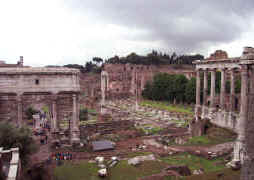|
During her Republican
period, before the first emperor ruled, ancient Rome fought a series of
long, devastating wars with Carthage, her rival for control of the western
Mediterranean Sea. Against Rome is the story of part of that series
of wars and the great men who fought on both sides--and the women they
loved.
The
adversaries engaged initially
in the First Punic War, from 264 - 241 B.C. At the time, Carthage ruled
the seas, but Rome soon outstripped her by building a large fleet and
gradually mastering maritime tactics. One of Rome's chief advantages in
this combat was the
corvus, a maneuverable gangplank carried aboard
Roman quinqueremes that could be dropped onto the deck of a Carthaginian
ship. The corvus had a spike at the end that caught the
Carthaginian in its grasp. Roman marines then stormed aboard and took the
Carthaginian ship, in the kind of land-based fighting at which they
excelled.
Rome won that first war,
imposing heavy penalties on Carthage. Years later, in 218 B.C., partly as
a result of Carthage's treatment at Roman hands, the great general
Hannibal marched a huge army from Spain, which Carthage controlled,
through southern Gaul (France) and over the Alps into Italy. The story of
Hannibal's march, especially the harrowing passage through the Alps with
winter hurtling on, is one of the most gripping in the annals of warfare
and courage.
The Romans tried to
interpose their legions between Hannibal and the city of Rome, but from
218 to 216 B.C. he delivered a series of hammer blows, defeating one Roman
army after another. Rome reeled under the assault, but she fought back,
though it would be some seventeen long years before the war finally
ended.
After the horrendous
battle of Cannae in 216 B.C., in which Hannibal's fifty thousand men
utterly destroyed a Roman army of eight legions--some eighty thousand
men--Rome took up a strategy of delay. For the next fifteen years, Fabius
Maximus, the Delayer, led Rome's fight as the war went first one way, then
the other. When would a Roman general arise who could finally defeat the
great Hannibal?
Meanwhile, in Spain,
Roman legions under Gnaeus Cornelius Scipio and his brother Publius took
on Hannibal's brother Hasdrubal. If they could wrest Spain from
Carthaginian control, the war would be over. But the Cornelius Scipio
brothers were both killed in 211 B.C.
But the next year,
Publius Scipio's young son, also called Publius Cornelius Scipio, somehow
won the opportunity to replace his father and uncle as commander in
Spain--at the age of 25, without having held any of the traditional
magistracies that led preeminent Romans to the consulship.
continues at top
of next column |
In
209 B.C., young Scipio
began an astonishing campaign against Hasdrubal, first seizing Hasdrubal's
base at New Carthage, then defeating Carthaginian armies in two great
battles. Hasdrubal fled with the remainder of his troops to join Hannibal
in Italy. On his way there, however, he encountered a Roman army in
northeastern Italy and was defeated at the Metaurus River in 207 B.C. The
victors lobbed Hasdrubal's head into Hannibal's camp in the south.
With Spain under control,
Scipio became consul of Rome in 205 B.C. and started preparing an invasion
of Africa from his base in Sicily. In 204 B.C., as proconsul, he invaded
Africa and ravaged the lands around Carthage. Finally, in 203 B.C.,
Hannibal returned to Africa.
The next year, Scipio met
Hannibal in a decisive battle at Zama, south of Carthage. A student of
Hannibal for all of his career--Scipio was seventeen when Hannibal
invaded--Scipio had reformed Roman tactics to make the legions as flexible
as Hannibal's armies. At Zama, Scipio defeated Hannibal, who fled. Scipio
negotiated the peace settlement with Carthage and was given the title
Africanus for his triumph.
Scipio Africanus's
success was not the final chapter, however. That remained to be written by
Scipio's grandson (by adoption), Scipio Aemilianus, who destroyed Carthage
in a third war in 146 B.C., razing the city to the ground. Tradition has
it that he sowed the soil with salt so that Carthage could never revive.
Rome went on, however, to build her own Carthage, a Roman city, on the
site, and thereafter Rome ruled North Africa and the Mediterranean
Sea--and eventually the whole of the Mediterranean-European world.
The book is the story of
Hannibal's invasion and the start of Scipio's rise. A forthcoming sequel, Against
Hannibal, will take up the story after Cannae through Scipio's triumph
in 202 B.C.
§
About
the Book |

